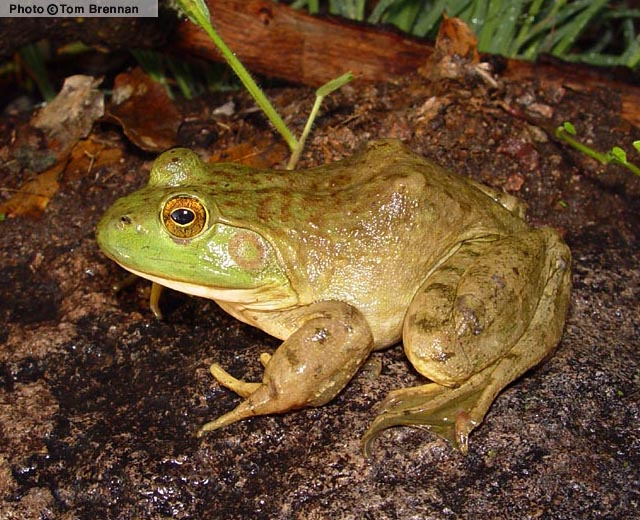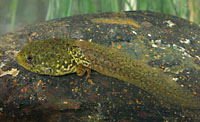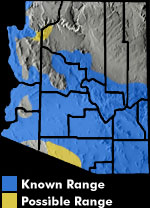Online Field Guide to The Reptiles and Amphibians of Arizona



Santa Cruz County, AZ
 Tadpole. Arizona |
| AMERICAN BULLFROG Lithobates catesbeianus | |
|
DESCRIPTION: At 8 inches or more in length, the American bullfrog is Arizona’s largest frog. It is a green or brownish-green frog with bands or blotches on the legs. Bullfrogs lack the spots and dorsolateral folds characteristic of leopard frogs. Males have tympanums that are as much as twice as large as the eye. Large tadpoles (up to 5.5 inches in length) are larger than the tadpoles of any of our native frogs and toads. Large tadpoles are olive or grayish-olive with diagnostic small, black dots. Small bullfrogs can be confused with Tarahumara frogs. See the description for that species for distinguishing features. DISTRIBUTION: Well-distributed and often abundant in permanent waters south and west of the Colorado Plateau. HABITAT: This is a frog of rivers, streams, lakes, cattle tanks, and agricultural ditches and canals; it coexists well with a variety of fishes and crayfish. Bullfrogs prefer deep pools and calm water, and occur from near sea level at Yuma to montane lakes and ponds at 7,000 feet or more. Tadpoles typically take 1-2 years to metamorphose, so permanent or nearly permanent water is needed for reproduction. BEHAVIOR: Can be found active day or night. When surprised, juveniles often give a “eep!” or “yip!” alarm call while jumping into water. Bullfrogs are surprisingly mobile. Juveniles, in particular, travel long distances overland among ponds and wetlands. In the Altar Valley, bullfrogs moved as much as 6.8 miles between ponds. DIET: Bullfrogs eat anything that moves and will fit into their mouths, including fishes, frogs, birds, bats, rattlesnakes, tarantulas, tarantula hawks, small mammals, and a variety of invertebrates. On the Colorado River, the highest volume prey item was crayfish. REPRODUCTION AND CALLS: Bullfrogs breed from spring to fall. Egg masses are laid in quiet water and may be attached to or lie within vegetation. Clutches may contain up to 20,000 eggs and cover an area 3 feet in diameter. Adult males make a deep “jug-o-rum” call, which is audible for great distances. REMARKS: The bullfrog is native to the eastern United States. The date of first introduction to Arizona is unknown, but they were introduced to California in the 1890’s, and by the late 1920s the species was reportedly common on the Colorado River at Yuma. Bullfrogs are awesome and voracious predators. Predation by bullfrogs has contributed to the decline and extirpations of native leopard frogs and gartersnakes. They are one of the biggest challenges to the recovery of the Mexican gartersnake and threatened Chiricahua leopard frog. Elimination of bullfrog populations is achievable in small, manageable wetlands, but is difficult or impossible in lakes, rivers, agriculture, and other complex habitats. Bullfrogs are also a vector for chytridiomycosis, a fungal disease that is killing frogs and toads around the globe. By Jim Rorabaugh Brennan, T.C., & A. T. Holycross. 2006. A Field Guide to Amphibians and Reptiles in Arizona. Arizona Game and Fish Department. Phoenix, AZ. Casper, G.S., and R. Hendricks. 2005. Rana catesbeiana Shaw, 1802, American bullfrog. Pages 540-546 in M.J. Lannoo (ed), Amphibian Declines: The Conservation Status of United States Species. University of California Press, Berkeley. Rosen, P.C., and C.R. Schwalbe. 2002. Effects of exotics on reptiles and amphibians. Pages 220-240 in B. Tellman (ed), Invasive Exotic Species in the Sonoran Region. University of Arizona Press and the Arizona-Sonora Desert Museum, Tucson, Arizona. 424 pp. Stebbins, R.C. 2003. A Field Guide to Western Reptiles and Amphibians, Third Edition. Houghton Mifflin Company, Boston, MA. |
|
Visit Partners in Amphibian and Reptile Conservation:


HOME
Copyright © 2023, Arizona Game and Fish Department. All rights reserved.
If you make use of the textual contents of this site in reports, publications, etc. please cite and credit the author(s) and photographer(s). All photos on this website are copyrighted. However, those found in the species account section may be used for any noncommercial scientific, educational, or conservation purposes provided that photographs are not altered and continue to bear the copyright symbol and name of the photographer. Please contact the photographer regarding commercial use of copyrighted photographs.










